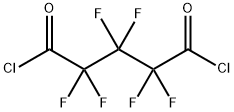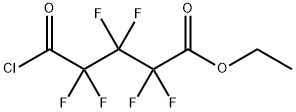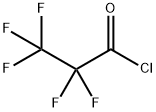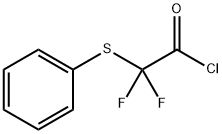FLUOROACETYL CHLORIDE
- CAS NO.:359-06-8
- Empirical Formula: C2H2ClFO
- Molecular Weight: 96.49
- MDL number: MFCD00015738
- EINECS: 206-623-6
- SAFETY DATA SHEET (SDS)
- Update Date: 2024-12-18 14:15:30

What is FLUOROACETYL CHLORIDE?
Description
Fluoroacetyl chloride is a liquid. Molecularweight=96.49. Hazard Identification (based on NFPA-704M Rating System): Health 4, Flammability 1, Reactivity 2.Reacts with water.
Chemical properties
Fluoroacetyl chloride is a liquid.
General Description
Liquid.
Air & Water Reactions
Reacts with water or moisture in air to form hydrochloric acid (hydrogen chloride)
Reactivity Profile
FLUOROACETYL CHLORIDE, an acid halide, when heated to decomposition, emits very toxic fumes of chlorine and fluorine-containing compounds. May react vigorously or explosively if mixed with diisopropyl ether or other ethers in the presence of trace amounts of metal salts [J. Haz. Mat., 1981, 4, 291].
Health Hazard
Highly toxic by inhalation. (Non-Specific -- Chloroacetyl Chloride) Corrosive to skin and irritating to eyes.
Fire Hazard
When heated to decomposition, FLUOROACETYL CHLORIDE emits very toxic fumes of chlorine and fluorine-containing compounds. (Non-Specific -- Chloroacetyl Chloride and Fluoroacetic Acid) Some of these materials may ignite combustibles (i.e., wood, paper, oil, etc.) or react violently with water.
Safety Profile
Poison by inhalation. When heated to decomposition it emits very toxic fumes of Cland F-. See also FLUORIDES and CHLORIDES.
Potential Exposure
May be used in organic synthesis.
First aid
If this chemical gets into the eyes, remove anycontact lenses at once and irrigate immediately for at least15 min, occasionally lifting upper and lower lids. Seekmedical attention immediately. If this chemical contactsthe skin, remove contaminated clothing and wash immediately with soap and water. Seek medical attention immediately. If this chemical has been inhaled, remove fromexposure, begin rescue breathing (using universal precautions, including resuscitation mask) if breathing hasstopped and CPR if heart action has stopped. Transferpromptly to a medical facility. When this chemical hasbeen swallowed, get medical attention. Give large quantities of water and induce vomiting. Do not make an unconscious person vomit. Effects may be delayed; keep victimunder observation.
storage
Color Code—Blue: Health Hazard/Poison: Storein a secure poison location. Prior to working with thischemical you should be trained on its proper handling andstorage. Store in tightly closed containers in a cool, wellventilated area.
Shipping
UN2810 Toxic liquids, organic, n.o.s., Hazard Class: 6.1; Labels: 6.1-Poisonous materials, Technical Name Required. UN2922 Corrosive liquids, toxic, n.o.s., Hazard class: 8; Labels: 8-Corrosive material, 6.1-Poisonous materials.
Incompatibilities
Compounds of the carboxyl group react with all bases, both inorganic and organic (i.e., amines) releasing substantial heat, water and a salt that may be harmful. Incompatible with arsenic compounds (releases hydrogen cyanide gas), diazo compounds, dithiocarba mates, isocyanates, mercaptans, nitrides, and sulfides (releasing heat, toxic and possibly flammable gases), thio sulfates and dithionites (releasing hydrogen sulfate and oxi des of sulfur). Chlorides or fluorides may ignite combustibles (i.e., wood, paper, oil, etc.) or react violently with water forming hydrochloric acid.
Properties of FLUOROACETYL CHLORIDE
| Boiling point: | 71°C |
| Density | 1.38 |
| EPA Substance Registry System | Fluoroacetyl chloride (359-06-8) |
Safety information for FLUOROACETYL CHLORIDE
| Signal word | Danger |
| Pictogram(s) |
 Corrosion Corrosives GHS05  Exclamation Mark Irritant GHS07 |
| GHS Hazard Statements |
H314:Skin corrosion/irritation |
| Precautionary Statement Codes |
P232:Protect from moisture. P260:Do not breathe dust/fume/gas/mist/vapours/spray. P280:Wear protective gloves/protective clothing/eye protection/face protection. |
Computed Descriptors for FLUOROACETYL CHLORIDE
New Products
Tert-butyl bis(2-chloroethyl)carbamate 4-Methylphenylacetic acid N-Boc-D-alaninol N-BOC-D/L-ALANINOL 3-Morpholino-1-(4-nitrophenyl)-5,6-dihydropyridin- 2(1H)-one Furan-2,5-Dicarboxylic Acid Tropic acid 1,1’-CARBONYLDIIMIDAZOLE DIETHYL AMINOMALONATE HYDROCHLORIDE R-2-BENZYLOXY PROPIONIC ACID 1,1’-CARBONYLDI (1,2-4 TRIAZOLE) N-METHYL INDAZOLE-3-CARBOXYLIC ACID (2-Hydroxyphenyl)acetonitrile 4-Bromopyrazole 5-BROMO-2CYANO PYRIDINE 5,6-Dimethoxyindanone 5-broMo-2-chloro-N-cyclopentylpyriMidin-4-aMine 2-(Cyanocyclohexyl)acetic acid 4-methoxy-3,5-dinitropyridine 2-aminopropyl benzoate hydrochloride 1-(4-(aminomethyl)benzyl)urea hydrochloride diethyl 2-(2-((tertbutoxycarbonyl)amino) ethyl)malonate tert-butyl 4- (ureidomethyl)benzylcarbamate Ethyl-2-chloro((4-methoxyphenyl)hydrazono)acetateRelated products of tetrahydrofuran








You may like
-
 2033-24-1 98%View Details
2033-24-1 98%View Details
2033-24-1 -
 1975-50-4 98%View Details
1975-50-4 98%View Details
1975-50-4 -
 2-HYDROXY BENZYL ALCOHOL 98%View Details
2-HYDROXY BENZYL ALCOHOL 98%View Details
90-01-7 -
 2-Chloro-1,3-Bis(Dimethylamino)Trimethinium Hexafluorophosphate 221615-75-4 98%View Details
2-Chloro-1,3-Bis(Dimethylamino)Trimethinium Hexafluorophosphate 221615-75-4 98%View Details
221615-75-4 -
 61397-56-6 CIS BROMO BENZOATE 98%View Details
61397-56-6 CIS BROMO BENZOATE 98%View Details
61397-56-6 -
 14714-50-2 (2-Hydroxyphenyl)acetonitrile 98+View Details
14714-50-2 (2-Hydroxyphenyl)acetonitrile 98+View Details
14714-50-2 -
 118753-70-1 98+View Details
118753-70-1 98+View Details
118753-70-1 -
 733039-20-8 5-broMo-2-chloro-N-cyclopentylpyriMidin-4-aMine 98+View Details
733039-20-8 5-broMo-2-chloro-N-cyclopentylpyriMidin-4-aMine 98+View Details
733039-20-8